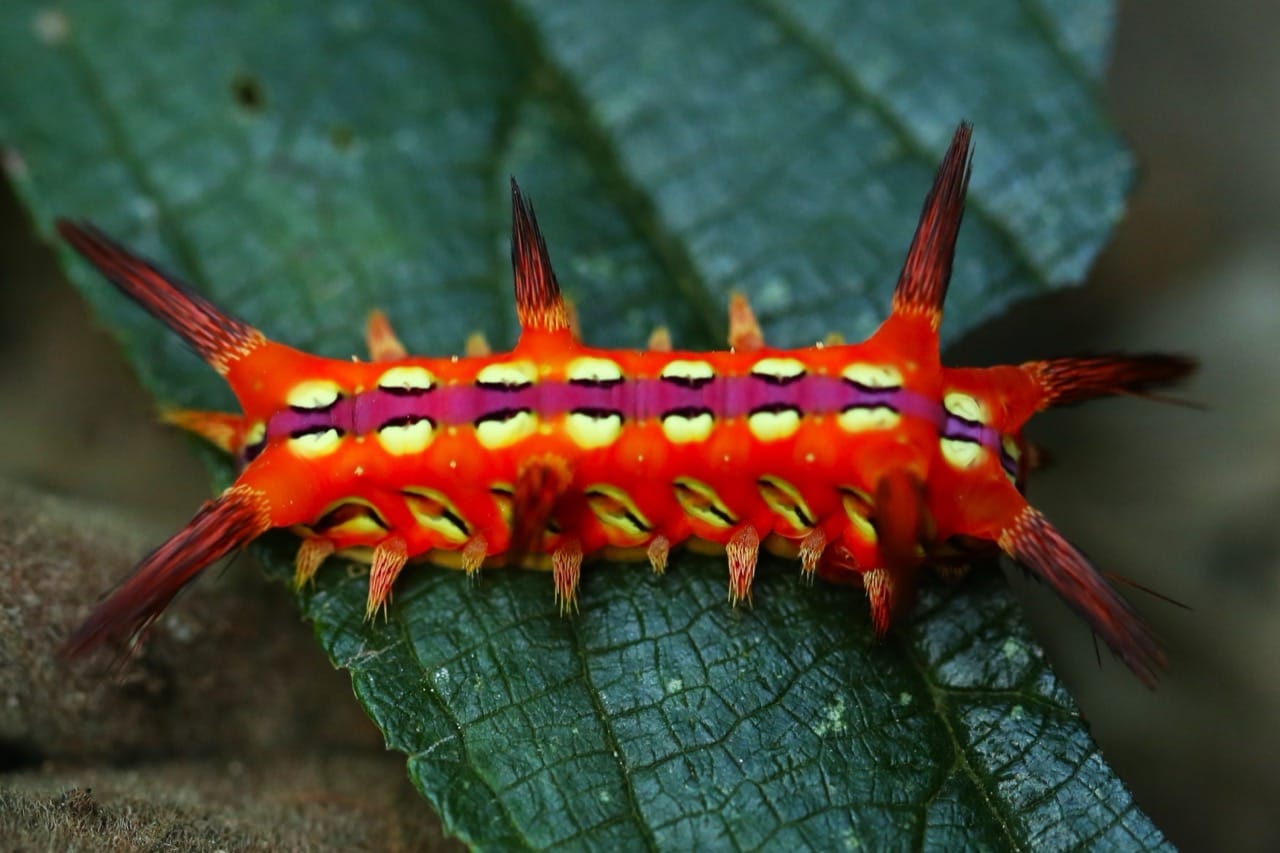In the intricate tapestry of nature, where every thread has a story, the Stinging Rose Caterpillar (Parasa indetermina) emerges as a vibrant spectacle. This larval form of the moth from the Limacodidae family is not only a feast for the eyes with its vivid colors and unique physical structure, but it also carries a hidden defense mechanism that makes it one of the most interesting caterpillars to study. This article dives into the fascinating world of the Stinging Rose Caterpillar, exploring its life cycle, behavior, and interactions with its environment.
Characteristics / Physical Description
The Stinging Rose Caterpillar is renowned for its striking appearance. Typically measuring about 20-30 mm in length, this caterpillar showcases a bright array of colors, including hues of orange, yellow, and purple, segmented by transverse black bands. Each segment is adorned with spiny protuberances that are tipped in black, which are not just ornamental but serve as a defense mechanism against predators. These spines can inject venom from glandular cells beneath the skin, causing irritation and discomfort to potential threats.
Taxonomy and Classification
Parasa indetermina belongs to the order Lepidoptera, which encompasses all moths and butterflies. Within this order, it is classified under the family Limacodidae, commonly known as slug caterpillars due to their gelatinous appearance when viewed from above. This family includes various species that are known for their stinging capabilities and distinctive larval forms.
Behavior and Social Structure
The Stinging Rose Caterpillar is primarily solitary. Its vibrant coloration is a classic example of aposematism, where bright colors warn predators of the potential danger or unpleasantness of an encounter. During the larval stage, it focuses on feeding and growth, preparing for its transformation into a moth.
Habitat and Distribution
This caterpillar is commonly found in deciduous forests across North America, particularly favoring environments where its host plants, such as roses and other shrubs, thrive. Its distribution is influenced by the availability of these plants, which play a critical role in its survival and development.
Diet and Feeding Habits
The diet of the Stinging Rose Caterpillar is herbivorous, feeding primarily on the leaves of rose bushes and sometimes other nearby plants. This selective feeding helps in the accumulation of toxins which are then utilized in their spines as a chemical defense against predators.
Breeding and Reproduction
The life cycle of the Stinging Rose Caterpillar includes a complete metamorphosis from egg to larva, pupa, and finally, adult moth. Females lay eggs on the underside of host plant leaves, which hatch into larvae that immediately begin to feed. After sufficient growth, the larvae pupate, often on the ground among leaf litter, emerging as adults ready to reproduce and continue the cycle.
Relationship with Humans
Despite its stinging capabilities, the Stinging Rose Caterpillar poses minimal danger to humans. It is often considered a pest in rose gardens but can also be appreciated for its role in the ecological food web and its natural beauty. Educating gardeners about its lifecycle and ecological benefits can help mitigate negative impacts while promoting biodiversity.
Evolutionary History
The evolutionary adaptations of the Stinging Rose Caterpillar, including its stinging spines and vivid coloration, are prime examples of nature’s response to predatory pressures. These features have evolved to optimize survival through both deterrence and defense, showcasing a remarkable evolutionary strategy.
Use as Research Animals
In scientific research, the Stinging Rose Caterpillar offers valuable insights into the mechanisms of chemical defense and aposematism in insects. Studies on its venom can contribute to understanding how toxins can be used by organisms to deter predators and might even have implications for developing natural insecticides.
In conclusion, the Stinging Rose Caterpillar is not only a visually captivating creature but also an intriguing subject for scientific study and ecological observation. Its presence in nature reminds us of the complexity and interconnectedness of ecosystems, urging us to appreciate and preserve the natural world’s wonders.

